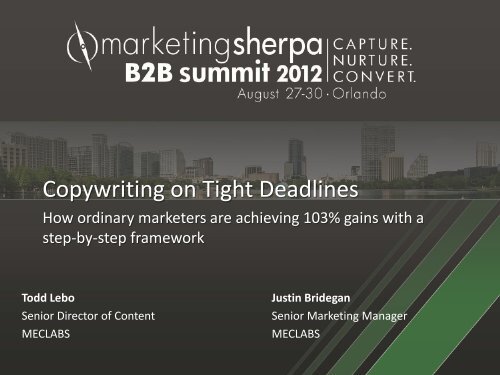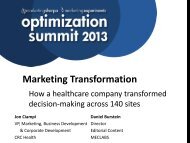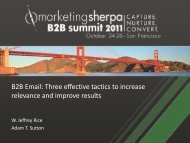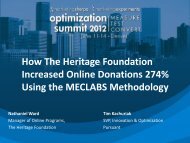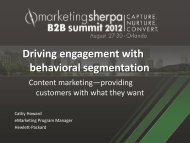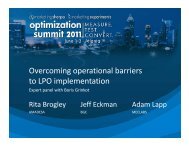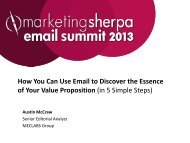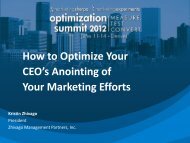Optimizing Your Message Learn strategies to write high ... - meclabs
Optimizing Your Message Learn strategies to write high ... - meclabs
Optimizing Your Message Learn strategies to write high ... - meclabs
You also want an ePaper? Increase the reach of your titles
YUMPU automatically turns print PDFs into web optimized ePapers that Google loves.
Copywriting on Tight Deadlines<br />
How ordinary marketers are achieving 103% gains with a<br />
step-by-step framework<br />
Todd Lebo<br />
Senior Direc<strong>to</strong>r of Content<br />
MECLABS<br />
Justin Bridegan<br />
Senior Marketing Manager<br />
MECLABS
Background and Test Design<br />
<br />
Experiment ID: Encyclopedia Britannica<br />
Location: MarketingExperiments Research Library<br />
Research Notes:<br />
Background: Well-known company offering an online encyclopedia<br />
subscription product<br />
Goal: To get visi<strong>to</strong>rs <strong>to</strong> sign up for a free trial<br />
Primary research question: Which landing page will have the <strong>high</strong>est<br />
subscription rate?<br />
Test Design: A/B split test (variable cluster)<br />
2
Experiment: Control<br />
Control<br />
Original Landing Page:<br />
• The headline does not<br />
communicate the value<br />
proposition<br />
• The “member benefits,”<br />
which are primary selling<br />
points, are in a separate<br />
column, not directly in the<br />
cus<strong>to</strong>mer’s eye path<br />
• The images on the left and<br />
bot<strong>to</strong>m do not help<br />
communicate anything<br />
about the service or why<br />
they should try it<br />
3
Experiment: Treatment<br />
Treatment<br />
Treatment Landing Page:<br />
• The new headline and subheadline<br />
describe exactly<br />
what you get<br />
• Bullets are used <strong>to</strong><br />
emphasize the valuable<br />
features of the service in an<br />
easy-<strong>to</strong>-read format<br />
• The new image is clearer<br />
and includes a caption that<br />
re-emphasizes the value<br />
proposition<br />
4
Experiment: Treatment<br />
Treatment<br />
Treatment Landing Page:<br />
• Activate <strong>Your</strong> Free Trial” is<br />
used instead of “Please<br />
Enter <strong>Your</strong> Billing<br />
Information” or “Subscribe<br />
Now” messaging<br />
• Savings over the print<br />
edition instantly shows the<br />
cus<strong>to</strong>mer the “value”<br />
• But<strong>to</strong>n copy emphasizes the<br />
“receiving” aspect of the<br />
transaction instead of<br />
“giving” language such as<br />
“submit”<br />
5
Experiment: Side-by-side<br />
Original<br />
Treatment<br />
6
Experiment: Results<br />
103% Increase in Conversion<br />
The Treatment generated 103% more free trial sign ups than the control<br />
Versions CR Rel. diff Stat. Conf<br />
Control 1.00% - -<br />
Treatment 2.03% 103%<br />
95%<br />
<br />
What you need <strong>to</strong> understand: By cutting meaningless “power copy” and<br />
clearly stating the value proposition, the treatment out-performed the<br />
control by 103%.
What we discovered<br />
<br />
Key Principles<br />
1. When it comes <strong>to</strong> crafting effective copy, clarity trumps persuasion.<br />
2. In order <strong>to</strong> achieve clarity, you must synchronize your copy <strong>to</strong> the<br />
thought sequences of the reader.<br />
3. Human thoughts tend <strong>to</strong> arrange themselves in s<strong>to</strong>ry. Therefore<br />
synchronizing your copy <strong>to</strong> the visi<strong>to</strong>r’s thought sequence requires a<br />
s<strong>to</strong>ry-based framework.
?<br />
How can I <strong>write</strong> effective copy without<br />
working late?<br />
9
Today we are going <strong>to</strong> learn a step-by-step copywriting<br />
framework that busy marketers can use <strong>to</strong> consistently<br />
<strong>write</strong> effective copy.<br />
10
How People Tend <strong>to</strong> Think<br />
SUB STORY<br />
Climax<br />
Climax<br />
Falling Act.<br />
Rising Act.<br />
Resolution /Exposition<br />
Exposition<br />
ACT 1 ACT 2 ACT 3<br />
Beginning (The Setup) Middle (The Confrontation) End (The Resolve)<br />
Resolution<br />
People’s thoughts tend <strong>to</strong> arrange themselves in s<strong>to</strong>ry,<br />
therefore understanding your visi<strong>to</strong>r’s thought sequence<br />
comes down <strong>to</strong> understanding the basic structure of a s<strong>to</strong>ry.<br />
Each part of the conversion process can be tied <strong>to</strong> s<strong>to</strong>ry…
How s<strong>to</strong>ry connects <strong>to</strong> the conversion process<br />
Climax<br />
Exposition<br />
ACT 1 ACT 2 ACT 3<br />
Beginning (The Setup) Middle (The Confrontation) End (The Resolve)<br />
Resolution<br />
The Exposition: As it relates <strong>to</strong> conversion, the main s<strong>to</strong>ry is usually set up in the channels<br />
(PPC, Email, Banners, etc.). The overarching goal of this step is <strong>to</strong> engage the visi<strong>to</strong>r, start<br />
building the problem, and lead them deeper in<strong>to</strong> the conversation. Keep in mind there is a<br />
sub-s<strong>to</strong>ry surrounding step-level conversion goal (getting them <strong>to</strong> click the ad, etc.).
How s<strong>to</strong>ry connects <strong>to</strong> the conversion process<br />
Climax<br />
Exposition<br />
ACT 1 ACT 2 ACT 3<br />
Beginning (The Setup) Middle (The Confrontation) End (The Resolve)<br />
Resolution<br />
The Rising Action: As it relates <strong>to</strong> conversion, the rising action is intensified mainly through<br />
the landing page. The overarching goal is <strong>to</strong> continue intensifying the problem and present<br />
your value as the unique solution. Keep in mind there is a sub-s<strong>to</strong>ry surrounding step-level<br />
conversion goal (getting them <strong>to</strong> click the ad, etc.).
How s<strong>to</strong>ry connects <strong>to</strong> the conversion process<br />
Climax<br />
Exposition<br />
ACT 1 ACT 2 ACT 3<br />
Beginning (The Setup) Middle (The Confrontation) End (The Resolve)<br />
Resolution<br />
The Climax: As it relates <strong>to</strong> conversion, the climax happens at the point of decision for the<br />
main conversion objective (<strong>to</strong> buy, submit information, etc.). Most of the time this happens<br />
at the call-<strong>to</strong>-action on the landing page, where the rising action is at the <strong>high</strong>est intensity.
How s<strong>to</strong>ry connects <strong>to</strong> the conversion process<br />
Climax<br />
Exposition<br />
ACT 1 ACT 2 ACT 3<br />
Beginning (The Setup) Middle (The Confrontation) End (The Resolve)<br />
Resolution<br />
The Falling Action: As it relates <strong>to</strong> conversion, the falling action occurs after the conversion<br />
commitment has been made, and consists of all the steps that might be required <strong>to</strong><br />
actualize the decision (filling out payment info, shipping info, etc.). The falling action might<br />
be virtually absent if the payoff on the conversion commitment is actualized immediately<br />
(free digital offers, etc.).
How s<strong>to</strong>ry connects <strong>to</strong> the conversion process<br />
Climax<br />
Thank you<br />
Exposition<br />
ACT 1 ACT 2 ACT 3<br />
Beginning (The Setup) Middle (The Confrontation) End (The Resolve)<br />
Resolution<br />
The Resolution: As it relates <strong>to</strong> conversion, the resolution occurs when the visi<strong>to</strong>r is aware<br />
of and satisfied with the completion (or actualization) of the value exchange. The goal is <strong>to</strong><br />
reassure the visi<strong>to</strong>r that the problem has been solved by their decision.
Connecting <strong>to</strong> Copy<br />
?<br />
So, how does s<strong>to</strong>ry help me <strong>write</strong> clear copy?<br />
ANSWER: By knowing where each copy element falls in the “the s<strong>to</strong>ry,” you<br />
can carefully craft each word, sentence and paragraph <strong>to</strong> specifically match<br />
the visi<strong>to</strong>r’s thought sequence.
Optimization Summit 2011 Example<br />
What’s wrong with this page?
Optimization Summit 2011 Example<br />
What’s wrong with this page?
Optimization Summit 2011 Example<br />
Original Draft<br />
Optimized Final<br />
Every piece of copy doesn’t have <strong>to</strong> be a masterpiece, but<br />
every piece of copy must be clear.
Optimization Summit 2011 Example: Results<br />
# of Tickets Sold<br />
180<br />
160<br />
140<br />
120<br />
100<br />
80<br />
60<br />
40<br />
20<br />
0<br />
14 13 12 11 10 9 8 7 6 5 4 3 2 1<br />
Weeks Out from the Event<br />
Projected<br />
Actual<br />
<br />
What you need <strong>to</strong> understand: The optimized final landing page generated<br />
more than twice the amount of tickets than originally projected, eventually<br />
leading <strong>to</strong> a completely sold out event.
Optimization Summit 2011 Example: Results<br />
Working from the<br />
framework, our<br />
copy<strong>write</strong>rs were able <strong>to</strong><br />
book every seat at the<br />
summit without writing<br />
flawless copy.
Introduction: The 3-step framework<br />
Exposition<br />
Example landing<br />
page from recent<br />
optimization summit<br />
Rising Action<br />
In the same way there are three acts in<br />
a s<strong>to</strong>ry, there are three steps <strong>to</strong> crafting<br />
compelling copy for (in this case) a<br />
landing page.<br />
STEP 1: Create your exposition<br />
STEP 2: Create your rising action<br />
STEP 3: Create your climax/resolution<br />
Climax
Step 1: Create your exposition<br />
S<strong>to</strong>ry click: Luke<br />
discovers The Force<br />
& his destiny<br />
Opening chase scene<br />
In a s<strong>to</strong>ry, the exposition does two things:<br />
1. Captures the audience’s attention<br />
2. Sets the stage for rest of s<strong>to</strong>ry by achieving<br />
“s<strong>to</strong>ry click.”
Step 1: Create your exposition<br />
On a landing page, the exposition is achieved through:<br />
1. An attention capturing headline<br />
2. A first paragraph with an obvious “s<strong>to</strong>ry click.”
Step 1: Create your exposition<br />
The Headline<br />
• The role of a landing<br />
page headline is <strong>to</strong><br />
arrest the visi<strong>to</strong>rs<br />
attention and get them<br />
in<strong>to</strong> the first paragraph.<br />
• Our testing suggests<br />
two effective <strong>strategies</strong>:<br />
1. Making a Promise<br />
2. Identifying a Problem
Step 1: Create your exposition<br />
The First Paragraph<br />
• The goal of the first<br />
paragraph is <strong>to</strong> get the<br />
visi<strong>to</strong>r in<strong>to</strong> the<br />
conversation. You do<br />
this by ensuring you<br />
answer three questions:<br />
1. Where am I?<br />
2. What can I do here?<br />
3. Why should I do it?<br />
• You must answer “what”<br />
before answering “why.”<br />
IMPORTANT NOTE: “S<strong>to</strong>ry click” occurs when all of<br />
those questions have been addressed.
Step 2: Create your rising action<br />
Intensifying fight scene<br />
Obi-Wan fights Darth<br />
Vader. Vader wins.<br />
In a s<strong>to</strong>ry, the rising action serves <strong>to</strong> intensify the problem.<br />
Rising action is marked by things like fight scenes, plot twists,<br />
character insights, etc.
Step 2: Create your rising action<br />
Web Page – Body Copy<br />
• On a landing page, most<br />
of the page copy will<br />
serve <strong>to</strong> intensify the<br />
problem and the<br />
solution.<br />
• We do this with five copy<br />
elements that we call<br />
“intensifiers”: proofs,<br />
features, benefits,<br />
incentive, and urgency.
The Rising Action<br />
Intensifiers<br />
Proofs: Specific statements – usually<br />
quantified – that bring credibility <strong>to</strong><br />
the value proposition. (e.g., “10,000<br />
landing pages tested…”)<br />
Benefits: Specific statements that<br />
demonstrate how the main value<br />
will benefit the visi<strong>to</strong>r’s current<br />
situation. (e.g., “Optimize your<br />
conversion processes…”)<br />
Features: Specific statements that<br />
provide the tangible details of the<br />
offer (e.g., “Attendees will receive<br />
benchmarks and analysis from X…”)
Step 2: Create <strong>Your</strong> Rising Action<br />
Intensifiers<br />
Incentive: An appealing<br />
element you introduce <strong>to</strong><br />
stimulate a desired action (e.g.,<br />
“All attendees will receive a<br />
copy of Bob Heyman’s new<br />
book…”)<br />
Urgency: An element of<br />
constraint you introduce <strong>to</strong><br />
stimulate a desired action<br />
within a specific time-frame.<br />
(e.g., “reserve you ticket <strong>to</strong>day<br />
and save $200”)
The Rising Action: Internal vs. external<br />
IMPORTANT NOTE: All five of these copy elements can appeal <strong>to</strong> both the internal<br />
and external challenges and triumphs of the character.<br />
External S<strong>to</strong>ry:<br />
Save the World<br />
The boss wants me <strong>to</strong> fix our metrics problems<br />
Internal S<strong>to</strong>ry:<br />
Become a Jedi Master<br />
I’d like <strong>to</strong> advance my career
Step 3: Create your climax/resolution<br />
Climax: Death Star explodes,<br />
rebels win.<br />
In a s<strong>to</strong>ry, the climax is the single event that everything builds <strong>to</strong>ward.
Step 3: Create your climax/resolution<br />
Web Page – Call <strong>to</strong> Action<br />
On a landing page, the climax is the main call <strong>to</strong> action.<br />
The goal is <strong>to</strong> lead the visi<strong>to</strong>r <strong>to</strong> (and through) the pivotal decision.
Step 3: Create <strong>Your</strong> Climax<br />
• Four questions <strong>to</strong> ask<br />
yourself about your call<strong>to</strong>-action<br />
(CTA):<br />
1. Is your CTA clearly visible?<br />
2. Does your CTA imply value,<br />
immediacy, or urgency?<br />
3. Does it come in the right time<br />
in the thought<br />
sequence/s<strong>to</strong>ry?<br />
4. Does your CTA ask or assume?
Summary: Putting it all <strong>to</strong>gether<br />
Exposition<br />
Climax<br />
Rising Action<br />
Proofs<br />
Benefits<br />
Features<br />
Incentive<br />
Urgency<br />
Exposition<br />
ACT 1 ACT 2 ACT 3<br />
Beginning (The Setup) Middle (The Confrontation) End (The Resolve)<br />
Overall, just like in a good s<strong>to</strong>ry, each<br />
part of the copy must be properly<br />
sequenced <strong>to</strong> match the visi<strong>to</strong>r’s<br />
natural flow of thought.<br />
Resolution<br />
Climax
Thank You<br />
Todd Lebo<br />
Senior Direc<strong>to</strong>r of Content<br />
MECLABS<br />
Todd.Lebo@MECLABS.com<br />
Justin Bridegan<br />
Senior Marketing Manager<br />
MECLABS<br />
Justin.Bridegan@MECLABS.com<br />
37


